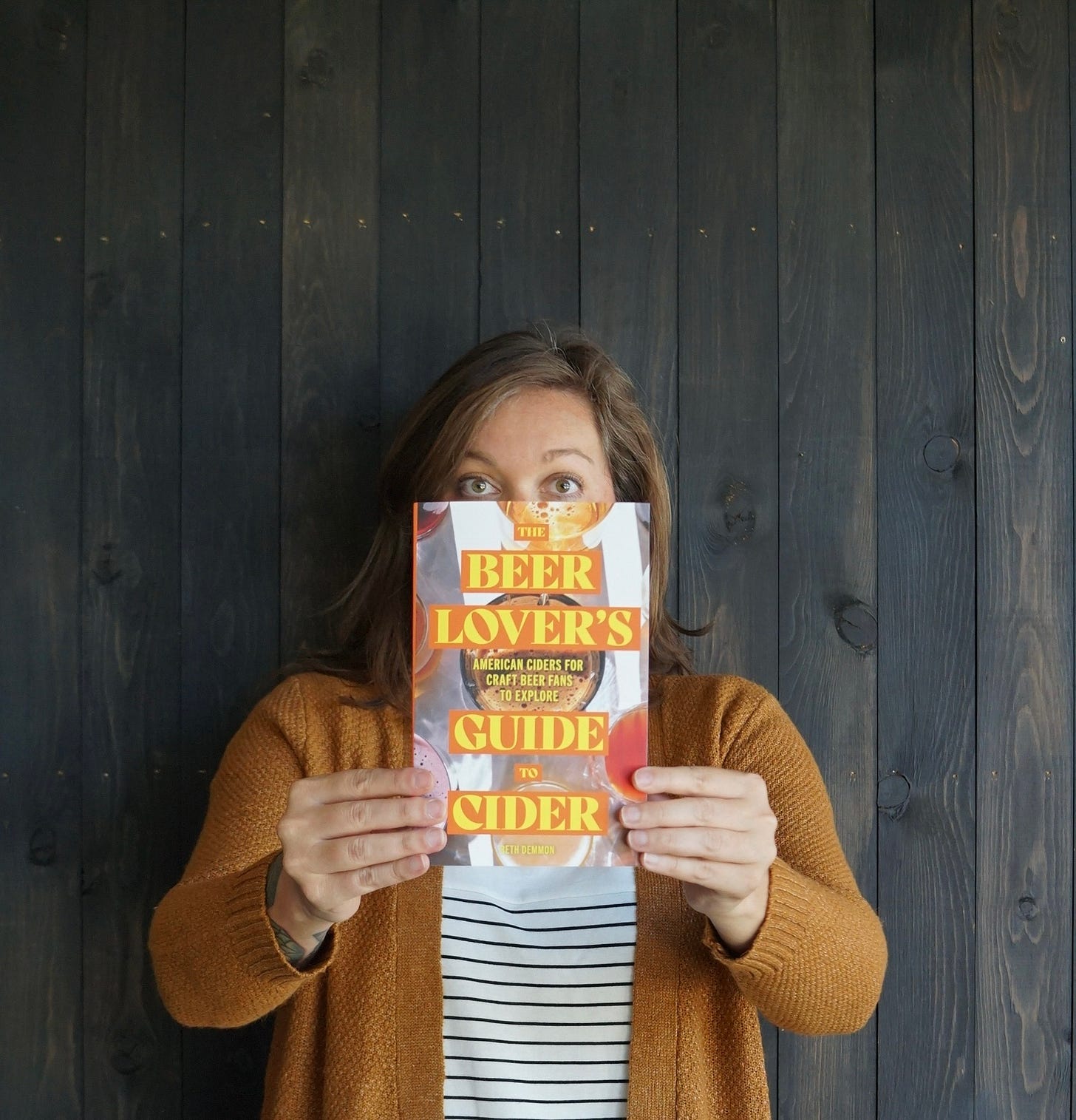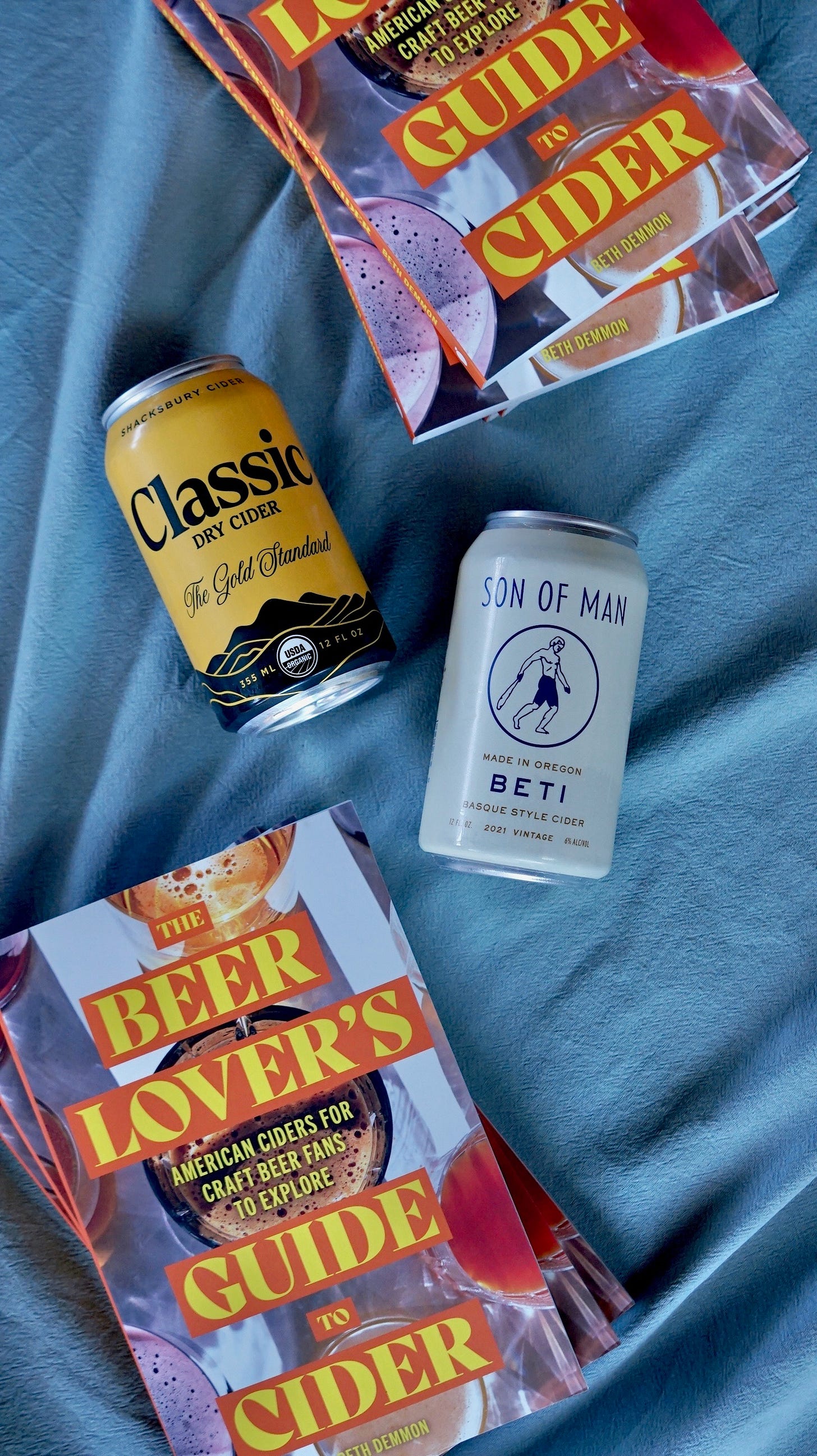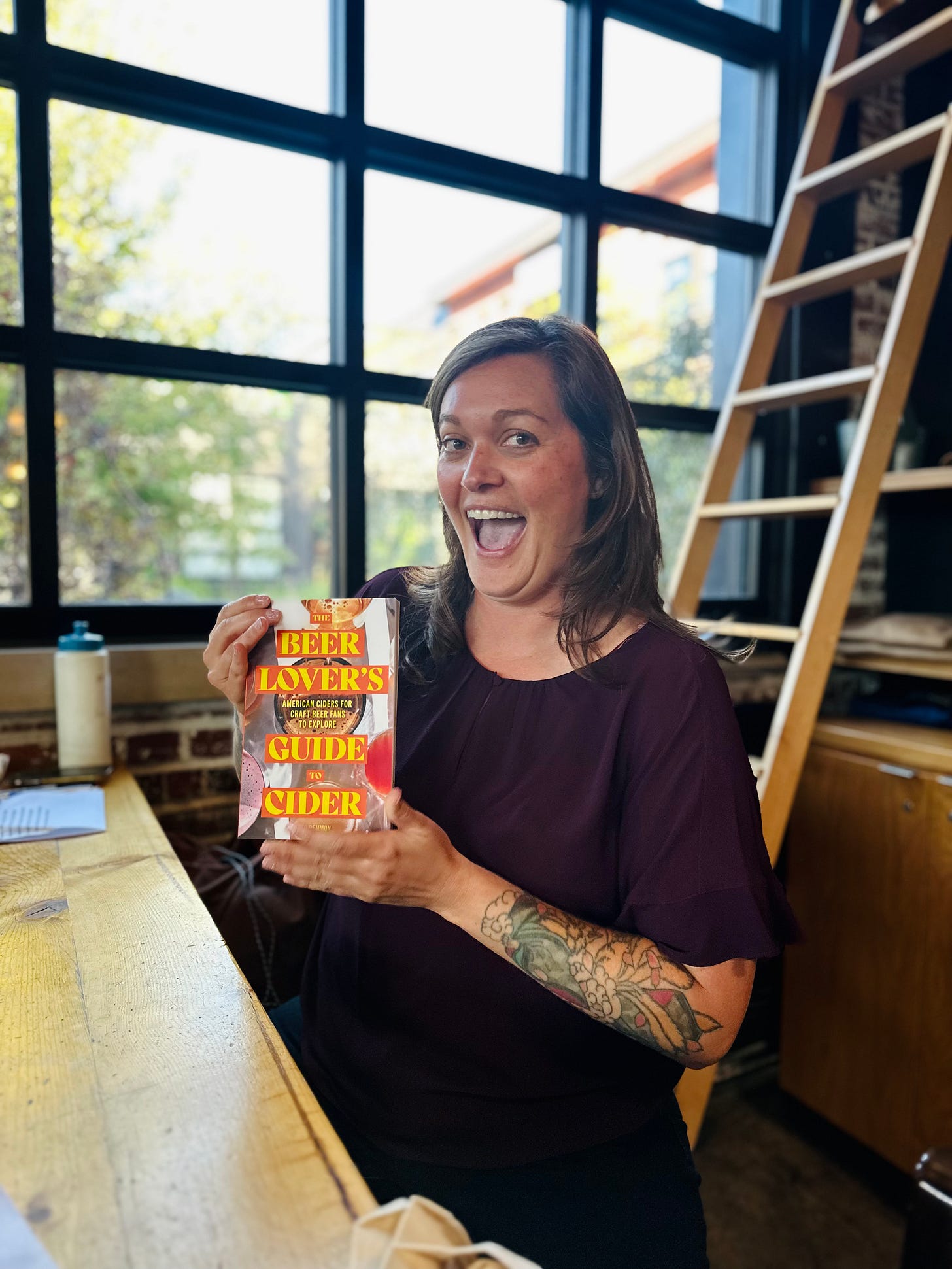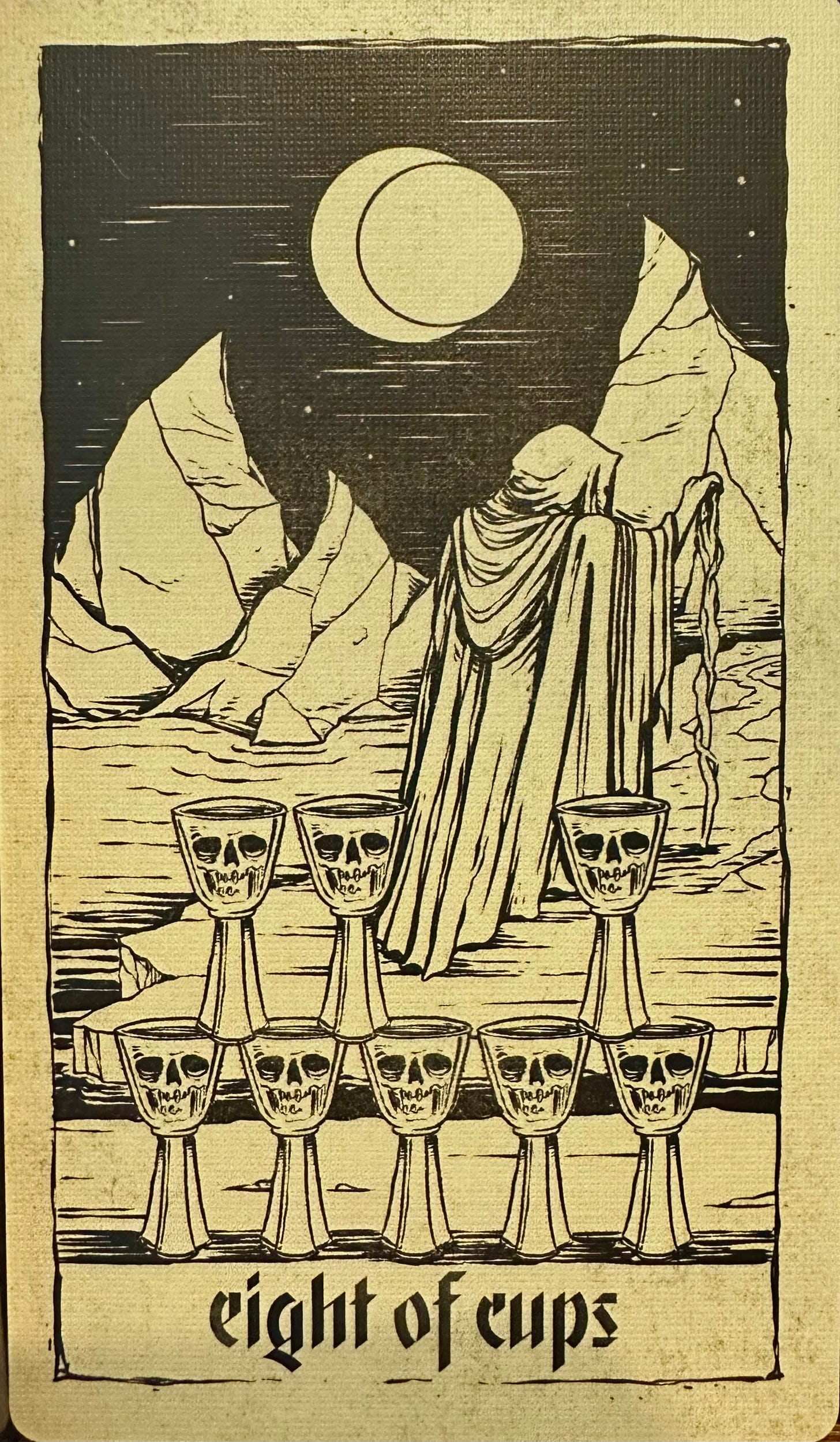109. Beth Demmon Is Getting A Lot of Us Beer Folks Excited About Cider
An interview with the prolific writer and now author(!) about "A Beer Lover's Guide to Cider"; plus Tarot for following Craig David's advice (hint: "Walking Away").
Brilliant Beer Lover Beth Demmon Is Now Also a Brilliant Cider Lover; Is Here to Help You Become One, Too.
I snatched up Beth Demmon’s “A Beer Lover’s Guide to Cider” like a greedy little fiend, and this vibrant book has certainly not disappointed. Some of my favorite things about it, in no particular order: It delivers on the Beth Demmon genius I have come to know and love from Beth’s writing in past years. There’s thoughtful and knowledgeable beer-judge sagacity and guidance, but now for cider, too! There’s candid and sharp-sighted insight on everything from industry growth and trends to DEI issue status. There’s the entire framework of helping us beer lovers quickly and easily dive into the world of cider with beer-related reference points that put things in perspective for us but also help us jump off from beer fully into cider from there. I’d call it a crash course because of how effortless and accessible the learning feels, but it’s more intentional and lasting than what that term implies. I also appreciate, by the way, that this incredibly handy book is not a giant coffee-table clunker—I have grabbed it countless times already from my desktop bookshelf and even traveled with it so far, keeping it close for easy flipping and referencing.
You know Beth. Perhaps you even already know and love this new book. If you don’t, you can get it on Amazon or Bookshop.org, for starters. And so, without further ado, let’s get into this fun, cider-ific chat I had with Beth about the book.
How did your own interest in cider spark—you’re the beer lover who got into cider and then wrote the book to help others follow suit, so what inspired you?
So, two things sort of happened. One was that one of my very best friends in the whole world started making cider at a small cidery in rural Virginia in 2013. And he’s the one who originally got me into beer in the first place. When we were in Richmond, Virginia, he lived there. I was going to college there and we were drinking Budweiser and Maker’s Mark. I don’t know why that was our drink, but it was. We slowly sort of got into craft beer a little bit. And so that was what started my journey when I was 20, 21, 22. Fast forward to 2013, and I was 28, he started sending Ashton and I bottles of cider that he was making.
And so I was introduced to craft cider through Andy [Hannas], and he works at Potter’s Craft Cider in Charlottesville, Virginia. He’s the head cidermaker there. But I didn’t really know or care about cider at that point until he started sending us bottles. And I was like, “These are amazing. I’ve never had cider like this. I didn’t know cider could be like this.” Their flagship bottle was a farmhouse dry, so it was just a very simple, elegant, bubbly, rustic cider that was super easy to drink, but very complex.
And so I just started getting into it a little bit through what he was sending me and then starting to pick up a bottle or some cans here and there on my own. But if he hadn’t started doing that, I’m not sure that this would have ever happened because cider is just not as easy to stumble across as beer is. And until that point, I would have called myself a beer drinker. I drank beer and really nothing else. Maybe the occasional cocktail; pretty much never wine. It was beer or nothing. And it was really easy because I live in San Diego and I don’t have to try to find good beer. I sneeze and it lands on five great breweries. So I had to start actively looking for cider. And I was surprised at what I found.
But at the same time, writing about beer, I was seeing a shift in consumer behavior, not just in my age group, 35 to 44, but the younger drinkers, too…People who called themselves wine drinkers or beer drinkers, that sort of stopped happening with Gen Z. They just became curious drinkers, and they liked certain flavors, and they didn’t really care what type of alcohol it was. They just wanted something that tasted like pineapple that day, or they wanted something that was really malty that day or something that would warm them up on a cold day. It’s more vibes-driven, I guess, than spirit-driven. And I thought that it was a good opportunity to identify people who were drinking in different ways and use my own personal transformation to offer cider as something interesting and worth paying attention to, even though it's not as pervasive as spirits, beer, or wine. But I think it could be if people knew the diversity of cider that’s being made just in the United States.
How did this all turn into the idea for a book?
The idea came about in early 2020 at CiderCon in Oakland, where I was on a panel where it was a beer person, a wine person, and a cider person. And we drank wine, beer, and cider side by side and discussed the similarities and differences between them. And I saw how engaging the conversation was for people. And so that’s when I had the idea for the book because I was interested in it, I saw that other people were interested in it, and it hadn’t really been presented in that way yet.
Why did you want to take this specific angle of speaking to beer drinkers about cider?
I mean, selfishly, that’s my background. It’s what I know the most about. And realistically, the overlaps between wine and cider have been discussed. I mean, cider is wine. It’s just the fermented juice of a different fruit. And so I think that wine drinkers are already familiar enough with cider to where I think that there could certainly be “the wine lover’s guide to cider.” And I think that would be just as valuable. But I think “The Beer Lover’s Guide to Cider” was a little bit of—there was more to say that hadn't been said yet. And just coming from beer, it was something that I knew I could speak to with relative authority because I speak the beer language; I learned and am still learning how to speak the cider language. And I feel like there's an opportunity for people who are disengaging somewhat from beer to find something new. Cider seemed like something that people wouldn’t necessarily think of in the same way that wine people might think of cider already. I feel like beer people hadn’t really considered cider as an alternative. And I wanted to show them that it could be. And it could surprise them. And it could engage them in a way that they might not have expected.
So, when you were setting out to speak to beer lovers about cider, were there specific questions or, honestly, misconceptions that you saw out there that you wanted to address?
The framework started as, “if you like these styles of beer, here are some ciders that you might like, and here’s why you might like them.” And so, I think it didn’t start out as anything more than a guide, but I do think that there are a lot of misconceptions about cider in general, not just from beer people. Just the industry, in general, is misunderstood in a lot of ways. And I do talk about that in the book. But I think one big misconception is people think cider is sweet. And I would agree that a lot of the mass-produced, very easy to find cider is sweet, because that’s what a general kind of drinking public tends to want. That’s not what necessarily the craft consumer or the connoisseur always wants. And so, I think that was one misconception that was important for me to address.
I also think that people think cider is very simple. There are fewer ingredients than there are in beer. So by the virtue of mathematics, people think that there’s going to be less variety of flavor and experience. And that’s not true at all. I think if you’re talking about cider when it’s just the fermented juice of apples, sure. I mean, there’s only so many apple varieties out there. I think there’s more than people know about, and there’s more diversity even in that type of cider. But when we’re talking about American ciders specifically, there’s a level of innovation there that I don't think people know about. And I think that the craft beer consumer specifically would be really interested in because a lot of craft beer is very experimental; it’s very esoteric. It’s not necessarily adhering to European beer traditions. There’s a lot of that. But I think that the United States, in general, is a lot more open to experimentation than maybe other places in the world are. And I think that cider is just as innovative as any other segment out there, but it’s just a little less visible.
I wanted to really nurture a sense of surprise and discovery that I think the hardcore craft beer consumer enjoys. I think beer people like finding out stuff that’s new, and they like sharing with their friends, they like introducing to other people…Cider is a really great way to do that.
In the book, you write about how craft cider has had its own boom in the past decade, going from 300 in 2013 to around 1,800 today. I’m curious why you think that could be happening right now. And, in addition to that, because you also give the context that “Big Cider” is one of the reasons the number of craft cideries was indeed so small for so long, do you see parallels between the growth of craft cider now and the growth of craft beer decades ago?
I 100% see similarities between the trajectory of craft beer 20 years ago and craft cider today. I don’t necessarily think that craft cider will follow the same path or ever be as big as craft beer is just by virtue of access to ingredients. There just aren’t enough apple trees to support 9,000-plus cideries in the United States. But I see a lot of similarities in that trajectory in terms of it being driven by very small local and regional cideries right now.
The big macro cideries right now, they're not really driving the growth of American cider right now. I would say that they are setting the trends we're seeing. If Angry Orchard releases one mango cider, by virtue of their market share, the flavor of the year for American cider is going to be mango. It doesn't necessarily mean that that's actually what is happening or growing. They’re such an outlier that their influence is outsized. And so when you're looking at the grassroots growth, it is coming from small, local, independent, and sometimes regional-size cideries versus the big guys. And I think that's what we saw in beer 20 years ago. And I think that cider can look to what beer did to learn and avoid some mistakes and maybe maximize their growth potential.
Speaking of which, something else you write about is the kind of strides the craft cider industry has taken in terms of diversity and inclusion. It still might not be where we ideally want to see things, but it seems like craft cider is more being built with DEI values from the ground-up, compared to craft beer, where most needed improvements still haven’t even been made. Do you think there is some advantage from craft beer being older, that craft cider as this burgeoning industry can look to craft beer and be correcting mistakes before they even happen, and learning what kind of industry would be better to build? Or is this just more organic within the cider industry itself?
I’m going to give a lot of credit to the American Cider Association for their efforts to introduce DEI initiatives as the status quo from the beginning rather than an afterthought. I think that they’re being very proactive rather than reactive in the way that beer is, in terms of embracing producers and consumers from all races, genders, walks of life. It is easier to build something from the ground up than it is to course-correct.
That’s where I think the American cider industry has an advantage over the American beer industry, because beer was built with the intention of being a white man’s drink…That’s who they marketed to in the ‘70s, ‘80s, ‘90s…today. That’s the core consumer. And the difference is with cider is, I do think on an industry level, the American Cider Association is really putting their money where their mouth is in terms of supporting people who want to open cideries. They are supporting hobbyists who are sort of cider-adjacent, whether they’ve got a podcast or they have an Instagram account or something like that. There are scholarships to come to CiderCon and…the Cider for Everyone movement, it pays for you to come to the conference. It pays for you to take the Pommelier exam. It’s really a way to make it as easy as possible for people to participate if they would like to, regardless of who they are.
I’d love for you to, as much as you can, pull back the curtain a little bit on your research process. Because with how comprehensive the options are and with how well they’re organized and the way that you organized it—to me, whew, this seems like it would have been a very overwhelming process. What did that look like?
Spreadsheets, spreadsheets, spreadsheets, so many spreadsheets. I mean, I had to be very methodical and very organized. But not really until the process started. I started emailing cideries, I started Googling, I looked at cideries in Virginia, cideries in Washington state, cideries in California. And I just made a list and I found email addresses and I said, “this is the project I'm working on. If you have any ciders to send me, that would be great. If you have a coupon code I could use, that would be great. If you just want me to buy them, that's fine, too. But any help that you could give to possibly be involved and mentioned in this project would be great.” I never promised that, “if you send it to me, you’re going to be in the book.” I was extremely transparent and honest from the beginning. And most people sent me cider. It was great because I think that cider people are hungry for new eyes and new mouths to walk in and discover them. So, the collection and tasting portion of the research was a good year and a half to two years. At one point, I was considering getting a third fridge just to hold everything because I couldn’t drink that fast and give it the attention that each one deserved. But I got through it. I persevered.
I had a spreadsheet of the name of the producer, the name of the product, the ABV, what it said on the label, the information given, the tasting notes that I took based on my BJCP judging experience. So I made sure to put the color, aroma, carbonation, mouthfeel, etc. And I just kept a really detailed log of what it was. And then I had broken down my outline for the book into the eight specific chapters of, “if you like these styles of beer, here are some products that you might like from the cider realm.”…
All in all, on the spreadsheet, I ended up with…gosh, I mean, it was something like 400 ciders, but that didn’t include stuff that I drank a couple of times or—some people sent me stuff that wasn’t cider but was like just a very bizarre sort of esoteric beverage, and I was like, “I love this, but this isn’t made with apples, so sorry.” And I also had to research where these things were distributed, and did they offer DTC shipping, and, you know, is this something that you could only get on draft at the cider house? Like, if you have to drive an hour and a half into the mountains of God knows where to try it…that’s not really going to be a helpful addition to the book, even if it’s a phenomenal cider.
Beer Tarot!
This week, I pulled the Eight of Cups.
Cups is the suit of love, emotions, and relationships, and the Eight of Cups in particular speaks to disappointment and walking away from something. Some part of your life or current situation you’re in is just not doing it. A relationship or job might have turned out to be totally unfulfilling, a pursuit of a certain goal may be proving not the right fit for you after all, a hobby or learning track might not be the best use of your time.
I know some of us have the tendency to lean too hard on “therapy speak,” but the Eight of Cups signals that you just simply are in some circumstance that does not serve you. And not in the way of, “this volunteer work is not convenient.” But in the way of, “this relationship/job/project is hurting my emotional/mental/physical health, is not fulfilling, and is not contributing to my life or my community or the world around me the way I thought it would.” Time is so, so, so precious. We have just the one life and a finite amount of days to fit our relationships and jobs and goals into. So, if something is not working, it’s okay—nay, good—to walk away. It’s not quitting if you’ve put thought into it and know this is just not the right fit for you. Don’t let whatever this is steal one more drop of energy from you, when you could be moving onto what is right for you. I think there’s a weird fixation on completionism in today’s culture. We waste valuable time slogging through prestige TV we don’t even like because, well, we started it. There are plenty of things you will stick to in life, things that are good for you, and it will be even easier to do so when you cut the dead weight. If a relationship or job is straight-up disappointing you, let alone hurting you in any way, gtfo.
Gtfo and find your…greener pastures! Which The Virginia Beer Co. has some of right here with the Greener Pastures NEIPA. It’s packed with Mosaic hops and sounds like a treat.
This Week’s Boozy Media Rec
Got a pairing for you this issue. First, read “How ‘conservative coded’ is cask ale?” on Boak & Bailey. Then, “Is American Craft Beer Liberal?” on Jeff Alworth’s Beervana. Both put into smart, articulate, compelling words something that’s always floated around in my brain that I couldn’t quite put my finger on. It’s not analyzing the specific political views of one particular brewery owner or another, but how, politically speaking, the entire scene is coded. The Boak & Bailey piece helped me understand and make sense of some assumptions versus some clear observations when it comes to cask ale in the UK and conservatism—and how that’s not necessarily clear-cut in distinctions, and Jeff’s piece similarly put some things in clear perspective. It’s interesting how so many taprooms can feel inherently liberal, how craft beer itself can feel liberal, and then there’s a certain kind of (older? brewpub? Stereotypes factor in here, no doubt) brewery that feels right-wingy. Very worthwhile discussion!
Ex-BEER-ience of the Week
I have to be totally honest here: I haven’t had much beer in the past two weeks. Woops! I got to enjoy the Strong Rope Red Hook taproom with family, and polish off some top-notch ESB from Old Thunder Brewing I had from writing this PUNCH piece. Other than that, it’s been a time for cocktails. Highlights: Checking out new NYC spot The Wooly (highly recommend), the Tinijuana at Jac’s on Bond, a filthy martini post-Daniel Sloss show at Mermaid Oyster Bar, a perfect gin martini pre-Sondheim concert “The Frogs,” and the vermouth service at my neighborhood spot Leland Eating & Drinking House.
In terms of beer-related experiences, though, it’s been a busy couple weeks for podcasts! I’ve had some really fun chats—check out this episode of Steal This Beer and this episode of A Woman’s Brew, and stay tuned for a couple more to come!
And don’t forget, you can head to Bean to Barstool to grab your copy of the Beer Tarot zine! OR, if you’re in NYC, swing by Wild East Brewing or Beer Witch—more stockists to be announced!
Until next time, here’s Darby in her popcorn get-up that won ~funniest costume~ at Leland’s adorable Dog-o-Ween event, thankyouverymuch.









